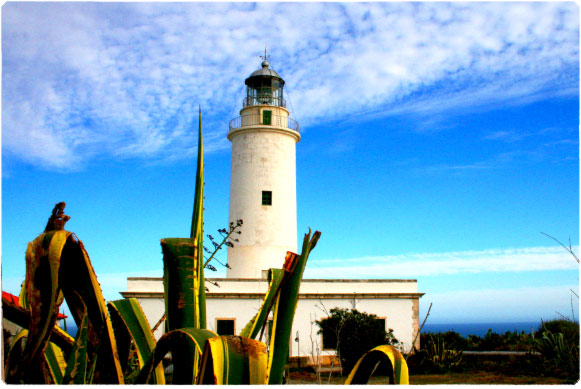
 |
All the territory which forms the geographical space called La Mola, is currently listed as NASI, Natural Area of Special Interest.
Around the lighthouse there are significant area of pine forest, alternating as mastic bushes, heather and rosemary.
But undoubtedly the most spectacular natural area is represented by the impressive cliffs that reach the lighthouse right in the height of 120 meters.
It is here where you can hear in the early evening hours, and depending on the time of year when we are, the song of the two species of pardela that breed in these parts and make the best existing colonies of these birds in the Western Mediterranean. These two species are the Cirendella pardela and pichoneta pardela known as Baldritxa and Virot.
The haunting sound of these “night cries” along with the spectacular twelve rotating beacon light beams ever, makes this enclave in a magical place to visit in the evenings Formentera.
It opened on 30th November 1861. The first light machine consisted of a fixed catadioptric on 2nd order of the French house Henry Lepaute and type oil lamp Degrand moderator. In 1928 it was installed a rotating optical reflectors twelve panels from Formentor Lighthouse and then adapted to modern French technology used a mercury float to speed rotary motion and reduce the time between flashes.
This view still serves today, appearing isolated light flashes every five seconds. That same year the old concentric lighters wick were removed to install a lighting system from incandescent oil vapor, kind Chance of 85 m / m, which employed silk hoods as a light source.
In 1970 the signal was electrified, replacing the old oil lamps with a lamp 3000 watt electric phase and two generators and emergency system. Its twelve-sided polygonal lanter, is the only of its kind that remains operational today in the archipelago, as in the rest of lights were installed cylindrical lanterns, curved glass and angled uprights. The lighthouse den Pou is also eight-sided polygon.
In 1944, the technician in charged rescued the pilot of a German plane that had dropped about two miles from the lighthouse, giving food, clothing and shelter. The next day was taken to the seaplane base that existed in the Estany Pudent, where he was repatriated. On these facts the German government, in full World War 2, the lighthouse keeper handed a diploma and a one thousand pesetas as a reward for their rescue work.
